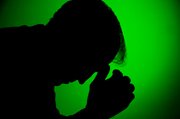Advertisment
New tweetment: Twitter users describe real-time migraine pain

Someone’s drilling an icicle into your temple, you’re throwing up, and light and sound are unbearable. Yes, it’s another migraine attack. But now in 140 characters on Twitter, you can share your agony with other sufferers. It indicates a trend toward the cathartic sharing of physical pain, as well as emotional pain on social media.
“As technology and language evolve, so does the way we share our suffering,” said principal investigator Alexandre DaSilva, assistant professor and director of the Headache and Orofacial Pain Effort at University of Michigan School of Dentistry. “It’s the first known study to show the instant and broad impact of migraine attacks on modern patients’ lives by decoding manually each one of their individual attack-related tweets.”
DaSilva’s team, including research fellows Thiago Nascimento and Marcos DosSantos, worked with 50 students and residents to categorize 21,741 tweets. They eliminated advertising, metaphor and nonrelated migraine tweets, which has not been done in previous studies. Further, they analyzed the meaning of each individual migraine tweet.
“We sought to evaluate the instant expression of actual self-reported migraine attacks in social media,” DaSilva said.
Results generated unique information about who suffers from migraines and what, how, where and when they use social media to describe their pain. The findings overlapped significantly with other traditional epidemiologic migraine studies, DaSilva and colleagues said.
Among other things, they examined the most common descriptors for migraines, including profanities, tweet times and locations, and impact on productivity and mood. Only 65 percent of the migraine tweets were from actual sufferers of migraines posting in real-time. Other tweets were advertising, general discussion, retweets, etc., indicating that not everything in social media is meaningful to the patient, DaSilva said.
Among the findings:
- Females accounted for about 74 percent of migraine tweets; males accounted for 17 percent.
- The higher global peak of migraine tweets occurred Mondays at 14:00 GMT, or 10 a.m Eastern Daylight Saving Time.
- The U.S. accounted for 58 percent of migraine tweets, followed by Europe at 20 percent.
- In the U.S., migraine tweets peaked at 9 a.m. and 8 p.m. on weekdays. The morning tweets peaked later on weekends.
- Roughly 44 percent of tweets reported that migraine attacks immediately impacted mood.
- The most common migraine descriptors were “worst” at nearly 15 percent and “massive” at 8 percent.
Migraines pose a huge public health problem, harming mood, productivity and overall quality of life. An estimated 12 percent of the Western world population suffer migraine attacks, and of those, 75 percent see reduced functionality.
The study appears April 3 in the Journal of Medical Internet Research. It will be available at: http://www.jmir.org/2014/4/e96
Alexandre DaSilva: http://bit.ly/1kFxzRu
U-M School of Dentistry: http://www.dent.umich.edu





